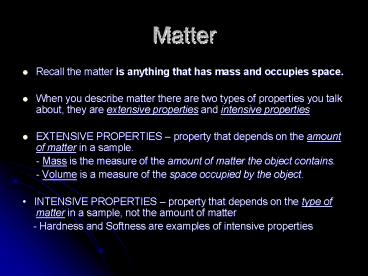Matter PowerPoint PPT Presentation
1 / 10
Title: Matter
1
Matter
- Recall the matter is anything that has mass and
occupies space. - When you describe matter there are two types of
properties you talk about, they are extensive
properties and intensive properties - EXTENSIVE PROPERTIES property that depends on
the amount of matter in a sample. - - Mass is the measure of the amount of
matter the object contains. - - Volume is a measure of the space occupied
by the object. - INTENSIVE PROPERTIES property that depends
on the type of matter in a sample, not the amount
of matter - - Hardness and Softness are examples of
intensive properties
2
Substance
- Substance is matter that has a uniform
composition throughout the entire sample - The diagram beside is a solution with two parts
taken out of it 1 and 2. If this is a substance
it will have the same composition no matter where
the part is take from. - The data below is the sample from the solution
that is beside. Explain. - Sample1 Sample2
- Parts O 1 1
- Parts H 2 2
3
Substance cont.
- Every sample of a substance has identical
intensive properties because the composition is
uniform throughout. - A physical property of a substance can be
measured or observed without changing the
chemical composition of the substance. - Examples of physical properties are hardness,
color, conductivity (conducts heat or
electricity), malleability (hammered into sheets
without breaking), and ductile (drawn into wire).
4
The 3 State of Matter(well 4 states)
- The 3 states of matter are solid, liquid, and
gas. - The fourth state of matter that we generally do
not talk about is plasma. No not the plasma found
in the blood but it is more like gas. - Solid
- has a definite shape and definite volume.
- Liquid
- has a definite volume but not a definite
shape (it takes the shape of the container it is
in). - Gas
- has no definite shape or no definite volume
(it changes with each container it is in)
5
Below are pictures that represent the 3 states of
matter. When the picture comes up find which
picture represents which state and explain why
you think that.
- This represents a solid because it is tightly
packed. Even though these are packed they still
move and vibrate against each other. - This is a liquid because it is still packed but
not as much - This represents a gas because the particles are
loose and go bounce around.
6
Mixture
- A mixture is two or more components put together.
- Two types of mixtures
- 1) Heterogeneous composition is not
uniform throughout - 2) Homogeneous composition is uniform
throughout. This is also called a solution.
7
MixtureBelow are two mixtures and for each
mixture two samples were taken and the data is
given. Tell which mixture is homogeneous and
which mixture is heterogeneous and explain your
reasoning.
- Mixture A sample 1 sample 2
- parts Cl 1 3
- parts Na 3 1
- Mixture B sample 1 sample 2
- parts Cl 2 2
- parts Na 3 3
8
Mixture Answer
- Mixture A is the heterogeneous mixture because
the samples of the same mixture have different
content. - Mixture B is the homogeneous mixture (solution)
because the samples of the same mixture have the
same content.
9
Separating Mixtures
- There are couple ways to separate mixtures, that
is filtration and distillation. - FILTRATION separates a solid from the liquid it
is in. - - An example of filtration is making pasta.
When you boil the pasta in water you have to
drain it so you pour the pasta and water into a
colander. The water passes through the holes
while the pasta stays in the pan. - DISTILLATION boiling a liquid till it is
vapor then cool it so it condenses again into a
liquid. - - The next slide shows a set up of the
distillation process
10
(No Transcript)

